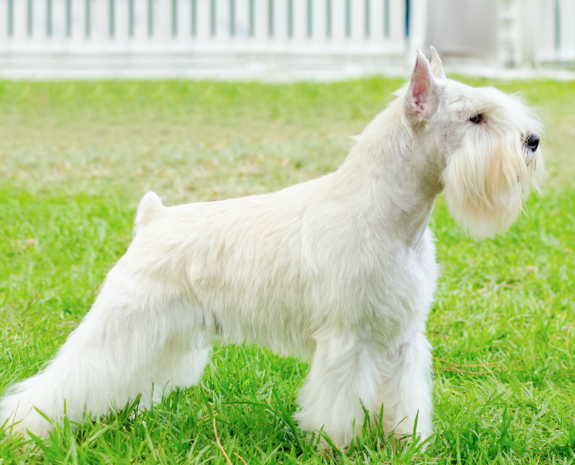
The AKC and Canadian Kennel Club breed standards for the Miniature Schnauzer make no mention of solid white as an allowed color (the AKC standard indicates that black is the only solid color allowed). Indeed, the American Miniature Schnauzer Club of America, the parent club of the breed, provides the following statement on its website regarding “off colors:”
Why not a White Miniature Schnauzer?
The Miniature Schnauzer was developed to be a smaller version of the Standard Schnauzer which has never come in the white color. In addition, in the US we believe almost all whites are highly likely to have another breed in the background (think West Highland White Terrier).
What about those Parti-color, Liver or Merle Miniature Schnauzers?
These are not colors or patterns ever associated with the Miniature Schnauzer. Some less-than-responsible breeders today are mixing in other breeds to achieve these off patterns and colors, marketing them as “rare and unusual” miniature schnauzers and charging the unsuspecting public big bucks for essentially mixed breed dogs! Buyer beware!
That said, the United Kennel Club standard does allow solid white, as does the FCI’s breed standard, and Coral Gray, an International All Breeds Judge, advises us that Dogs Australia (formerly the Australian National Kennel Control), updated the white Miniature Schnauzer breed standard in 2011 to be in line with the English Kennel Club. Furthermore, there have been several white Miniature Schnauzers shown in the conformation ring in Australia, and four have been awarded an Australian Champion title.
After this post first “aired,” we got an earful from fanciers on both sides of what appears to be a controversial, if not sore spot issue. We’ve updated some of the original text to be reflective of additional information, but what remains is the topic of where white in this breed even came from. The original post passed along theories we came across, but we’re sharing information provided by one breed fancier in the United States: She wrote:
There are lots of theories and speculation about how the breed was downsized. None factual as there was nothing in writing as which breeds were used. At the time, there were no official kennel clubs or pedigrees, and most likely, different breeders did different things. You mentioned [in the initial post] that two new colors emerged in the breed development, white and Black and Silver. It was actually white and parti color according to all the official breed books.
It is also surmised that because of that, some had used Wire Fox Terriers in the mix. The original breeders of white and parti color were told not to perpetuate it. The breed was developed to be an exact smaller replica of the Standard Schnauzer which does not come in white, and bicolor was always in Standard Schnauzers. The 1928 AKC standard also had Black and Tan as allowed, and they were in the terrier group at that time, minis considered a variety of Standard Schnauzer. In 1933, the breeds were separated and the Standard Schnauzer went in the working group. Sometime during WWII, the bicolor was disallowed in Standard Schnauzers in Europe, and then in the US.
There are many people breeding non-standard sizes, colors and coat types for the pet market in the United States: White, parti, liver, etc., but none of these colors come out of American show lines. Commercial breeders crossed with other breeds and submitted fraudulent paperwork. White was recognized in Germany because someone with money sued in court, and won. Breeders in Europe imported dogs from commercial breeders in the US, not from show lines, and not health testing. These kennel names are in virtually all white show pedigrees now. A few whites showed up in show lines in one show kennel in England and one in Argentina.”
We are quick to mention that we have no proverbial horse in this race, and also recognize that the aforementioned comment may rub some of our overseas readers the wrong way. The comments section is the place to express a different – and civil – point of view.
And finally, the hair of a white Schnauzer is free of pigments which is to say that it doesn’t contain the white color, but is colorless. The space in the keratinous layer of a hair is filled with air instead of a pigment, and this results in white color (ed note: in the art community, color theory purists still debate whether white is even a color at all since it represents the absence of hue or chroma. Just saying). White schnauzers don’t store pigment in the hair, they store it in the skin. Neither is it obvious at birth. Some Schnauzers are born with no pigment, and some are born beige and fade to white (these are sometimes called “false whites”). Others are a darker color genetically speaking, but carry a gene that masks their true color with white, and this isn’t apparent unless they have their own puppies which are born with dark color combinations.
Image: Deposit Stock Photo

I see this race for the first time. I think this little rascal will be the perfect complement to my dogs, who are the complete opposite – they are big and black in colour. Thanks people for this article and for the inspiration!